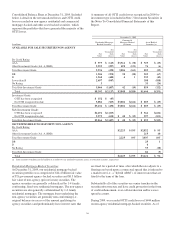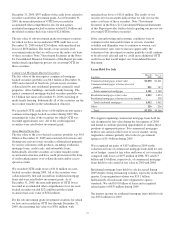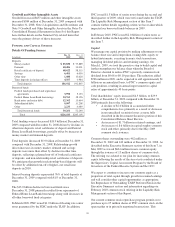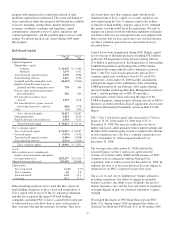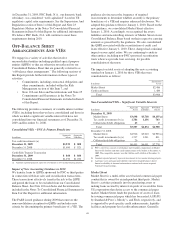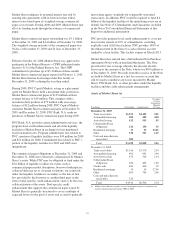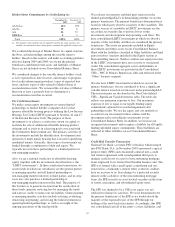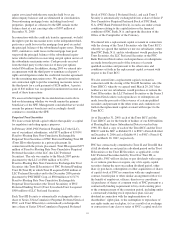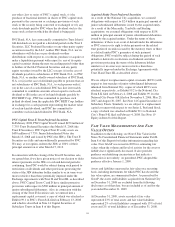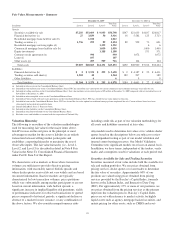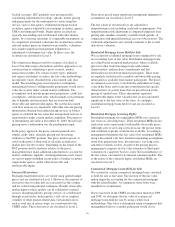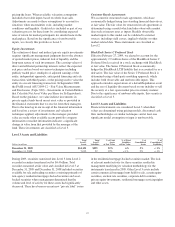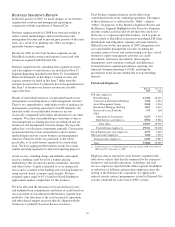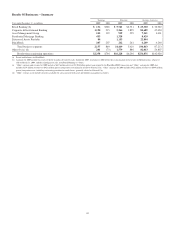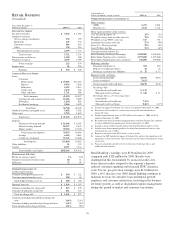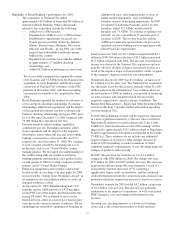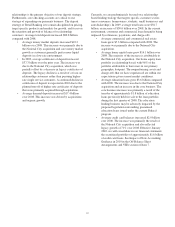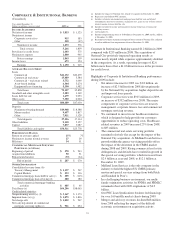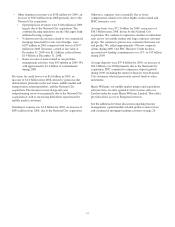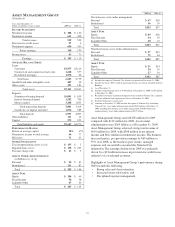PNC Bank 2009 Annual Report Download - page 50
Download and view the complete annual report
Please find page 50 of the 2009 PNC Bank annual report below. You can navigate through the pages in the report by either clicking on the pages listed below, or by using the keyword search tool below to find specific information within the annual report.backed securities. IDC primarily uses pricing models
considering adjustments for ratings, spreads, matrix pricing
and prepayments for the instruments we value using this
service, such as non-agency residential mortgage-backed
securities, agency adjustable rate mortgage securities, agency
CMOs and municipal bonds. Dealer quotes received are
typically non-binding and corroborated with other dealers’
quotes, by reviewing valuations of comparable instruments, or
by comparison to internal valuations. In circumstances where
relevant market prices are limited or unavailable, valuations
may require significant management judgments or
adjustments to determine fair value. In these cases, the
securities are classified as Level 3.
The valuation techniques used for securities classified as
Level 3 include using a discounted cash flow approach or, in
certain instances, identifying a proxy security, market
transaction or index. For certain security types, primarily
non-agency residential securities, the fair value methodology
incorporates values obtained from a discounted cash flow
model. The modeling process incorporates assumptions
management believes willing market participants would use to
value the security under current market conditions. The
assumptions used include prepayment projections, credit loss
assumptions, and discount rates, which include a risk premium
due to liquidity and uncertainty that are based on both
observable and unobservable inputs. We use the discounted
cash flow analysis, in conjunction with other relevant pricing
information obtained from either pricing services or broker
quotes to establish the fair value that management believes is
representative under current market conditions. For purposes
of determining fair value at December 31, 2009, the relevant
pricing service information was the predominant input.
In the proxy approach, the proxy selected generally has
similar credit, tenor, duration, pricing and structuring
attributes to the PNC position. The price, market spread, or
yield on the proxy is then used to calculate an indicative
market price for the security. Depending on the nature of the
PNC position and its attributes relative to the proxy,
management may make additional adjustments to account for
market conditions, liquidity, and nonperformance risk, based
on various inputs including recent trades of similar securities,
single dealer quotes, and/or other observable and
unobservable inputs.
Financial Derivatives
Exchange-traded derivatives are valued using quoted market
prices and are classified as Level 1. However, the majority of
derivatives that we enter into are executed over-the-counter
and are valued using internal techniques. Readily observable
market inputs to these models can be validated to external
sources, including industry pricing services, or corroborated
through recent trades, dealer quotes, yield curves, implied
volatility or other market-related data. Certain derivatives,
such as total rate of return swaps, are corroborated to the
CMBX index. These derivatives are classified as Level 2.
Derivatives priced using significant management judgment or
assumptions are classified as Level 3.
The fair values of our derivatives are adjusted for
nonperformance risk including credit risk as appropriate. Our
nonperformance risk adjustment is computed using new loan
pricing and considers externally available bond spreads, in
conjunction with internal historical recovery observations. The
credit risk adjustment is not currently material to the overall
derivatives valuation.
Residential Mortgage Loans Held for Sale
We account for residential mortgage loans originated for sale
on a recurring basis at fair value. Residential mortgage loans
are valued based on quoted market prices, where available,
prices for other traded mortgage loans with similar
characteristics, and purchase commitments and bid
information received from market participants. These loans
are regularly traded in active markets and observable pricing
information is available from market participants. The prices
are adjusted as necessary to include the embedded servicing
value in the loans and to take into consideration the specific
characteristics of certain loans that are priced based on the
pricing of similar loans. These adjustments represent
unobservable inputs to the valuation but are not considered
significant to the fair value of the loans. Accordingly,
residential mortgage loans held for sale are classified as
Level 2.
Residential Mortgage Servicing Rights
Residential mortgage servicing rights (MSRs) are carried at
fair value on a recurring basis. These residential MSRs do not
trade in an active open market with readily observable prices.
Although sales of servicing assets do occur, the precise terms
and conditions typically would not be available. Accordingly,
management determines the fair value of its residential MSRs
using a discounted cash flow model incorporating assumptions
about loan prepayment rates, discount rates, servicing costs,
and other economic factors. As part of the pricing process,
management compares its fair value estimates to third-party
valuations on a quarterly basis to assess the reasonableness of
the fair values calculated by its internal valuation models. Due
to the nature of the valuation inputs, residential MSRs are
classified as Level 3.
Commercial Mortgage Loans Held for Sale
We account for certain commercial mortgage loans classified
as held for sale at fair value. The election of the fair value
option aligns the accounting for the commercial mortgages
with the related hedges. At origination, these loans were
intended for securitization.
Due to inactivity in the CMBS securitization market in 2009
and 2008, we determine the fair value of commercial
mortgage loans held for sale by using a whole loan
methodology. Fair value is determined using assumptions that
management believes a market participant would use in
46


